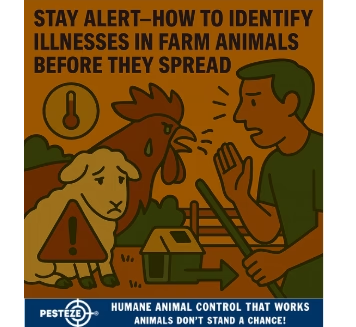IDENTIFYING ILLNESSES IN FARM ANIMALS

IDENTIFYING ILLNESSES IN FARM ANIMALS
SUMMARY
Early detection of illness in farm animals is critical for maintaining herd health, preventing outbreaks, and protecting productivity. This guide outlines the most common warning signs across species, how to monitor vital indicators, and when to seek veterinary help. Spotting symptoms early can save lives and reduce costs.
FEATURES
-
Behavioral Changes: Watch for isolation, lethargy, aggression, or unusual vocalizations.
-
Appetite and Digestion: Loss of appetite, bloating, diarrhea, or abnormal feces signal internal issues.
-
Movement and Posture: Limping, stiffness, or difficulty standing may indicate pain or injury.
-
Skin and Coat Condition: Dull fur, hair loss, lesions, or excessive scratching can point to parasites or disease.
-
Discharge and Breathing: Nasal discharge, coughing, labored breathing, or eye irritation are red flags.
-
Vital Signs Monitoring: Regular checks of temperature, heart rate, and respiration help detect hidden problems.
GUIDE DESCRIPTION
Farm animals are skilled at hiding illness, which makes early detection a challenge—but a critical one. Whether you’re caring for cattle, sheep, pigs, goats, or poultry, knowing what to look for can prevent suffering and protect your operation.
Behavioral changes are often the first clue. Animals that isolate themselves, stop interacting with the herd, or show signs of distress—like pacing, aggression, or excessive vocalization—may be unwell. These shifts in behavior should prompt closer inspection.
Appetite and digestion are key indicators. A healthy animal eats regularly and produces normal waste. Sudden refusal to eat, bloating, diarrhea, or feces that are too hard, watery, or blood-stained suggest internal issues like infection, parasites, or digestive disorders.
Movement and posture reveal pain. Limping, stiffness, or reluctance to stand or walk can signal injury, joint problems, or neurological issues. Animals may also grind teeth or groan when in pain.
Skin and coat condition offer visible clues. A healthy coat is smooth and shiny. Dull fur, bald patches, sores, or excessive scratching may indicate parasites, fungal infections, or nutritional deficiencies.
Respiratory signs are serious. Coughing, nasal discharge, labored breathing, or eye irritation can point to respiratory infections, allergies, or viral diseases. These symptoms often spread quickly in close quarters.
Vital signs should be checked regularly. Use a thermometer to monitor body temperature—fever is a common sign of infection. Heart rate and respiration should also be tracked, especially in animals recovering from illness or under stress.
When in doubt, consult a veterinarian. Early intervention can prevent outbreaks, reduce treatment costs, and improve animal welfare. A proactive approach to health monitoring keeps your farm running smoothly.
- Amy Chang


Comments 0